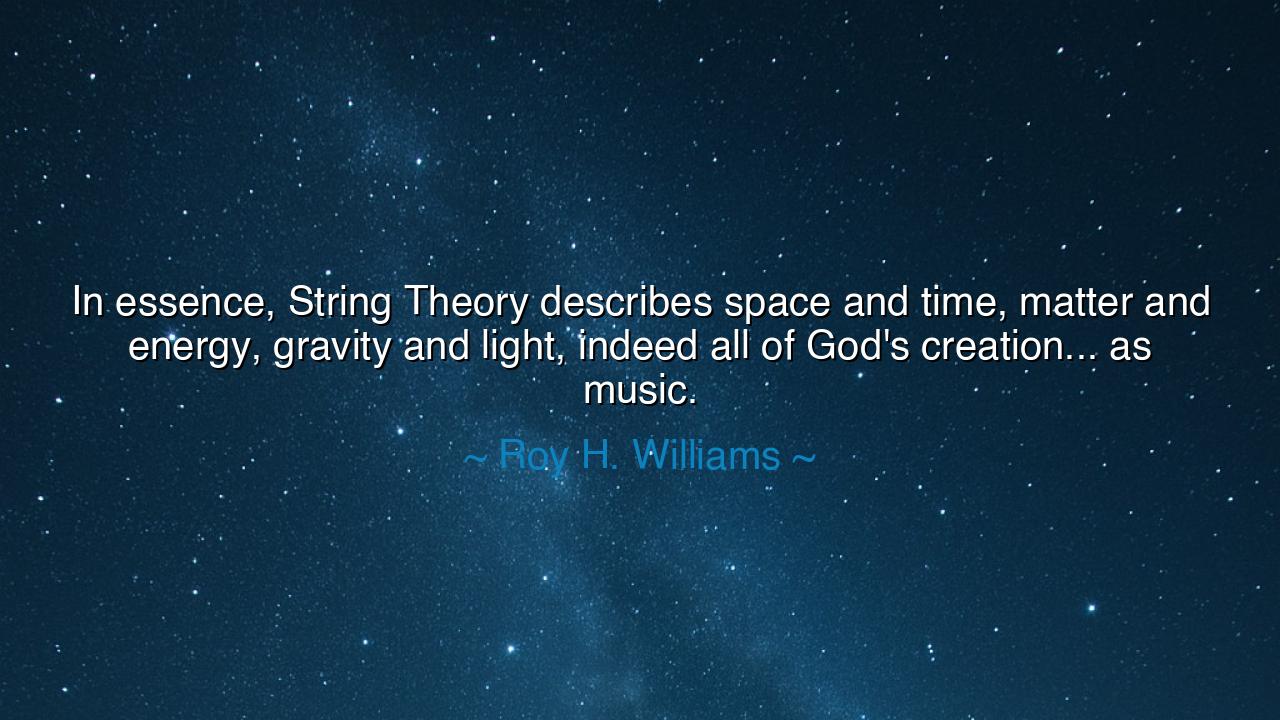
In essence, String Theory describes space and time, matter and
In essence, String Theory describes space and time, matter and energy, gravity and light, indeed all of God's creation... as music.






"In essence, String Theory describes space and time, matter and energy, gravity and light, indeed all of God's creation... as music." — these words by Roy H. Williams resonate like the echoes of a great truth, hidden deep in the fabric of the universe. They speak to the idea that all things—space, time, matter, energy, gravity, and light—are not separate, disconnected forces, but rather a harmonious symphony, a cosmic melody woven together by the threads of existence. This is a vision that stretches the boundaries of our understanding and invites us to see the universe as a grand composition, with each note and chord reverberating through the vastness of time and space. It challenges us to embrace a view of reality where everything is connected, where the rhythms of the cosmos are played in a vast, eternal concert.
In the days of the ancients, the heavens were seen as a realm of divine order, a place where the movements of the stars, the planets, and the gods themselves followed a precise and unyielding pattern. Pythagoras, the great philosopher and mathematician, spoke of the harmony of the spheres, a concept that the universe itself was governed by music, that the planets moved in accordance with mathematical laws that produced a celestial symphony. To the ancients, the idea that music could be the very language of the universe was not a mere metaphor; it was a sacred truth that bound the heavens to the earth. The stars themselves, in their silent dance, were thought to sing in harmony with the music of the spheres, a music only the wise could hear.
String Theory, as described by Williams, takes this ancient wisdom and places it at the cutting edge of modern physics. It proposes that the fundamental building blocks of reality are not particles, as once thought, but tiny, vibrating strings—each one creating its own unique vibration, its own sound in the vast symphony of existence. The theory invites us to envision the cosmos not as a collection of isolated entities but as an intricate, interconnected network of frequencies and vibrations. The sound of the universe is not just a poetic image; it is the very structure of reality itself, from the smallest quarks to the largest galaxies. Just as an orchestra requires the harmony of each instrument, the universe depends on the symphony of its forces.
Consider the example of Johann Sebastian Bach, whose compositions are timeless examples of musical harmony. In the same way that Bach weaved intricate patterns of sound into a beautiful whole, String Theory suggests that the universe is woven from a similar kind of harmony. Bach’s music, filled with its own complexity and grace, mirrors the elegance of the cosmos, a universe where the simplest elements—like the strings of an instrument—combine to form something far greater than the sum of their parts. In the same way, the forces that govern the universe—gravity, light, time, and matter—combine to create a majestic symphony that transcends the individual notes.
Yet, just as Bach's music requires discipline and order to be understood, so too must we approach the study of the universe with patience and reverence. String Theory, though still a mystery to many, challenges us to think of the universe not as a chaotic, fragmented entity, but as a harmonious whole, where every force, every particle, every wave, and every vibration is part of an interconnected melody. It calls upon us to tune our minds to the frequencies of the universe, to listen with the same intensity and clarity that one would listen to a grand piece of music.
The lesson of Williams’ words is clear: the universe is not a disjointed collection of random events, but a grand symphony, a composition in which every note matters, every vibration serves a purpose, and every movement is part of a greater design. The challenge is to see the music in the universe, to hear the harmony of creation in the flow of time, the unfolding of space, and the interactions of energy and matter. We are not mere observers of this symphony; we are part of it. Our lives, like every vibration, contribute to the overall harmony of existence. It is up to us to tune our hearts, to find our rhythm, and to understand that in every action, every thought, we are playing our part in the universal melody.
As we go about our lives, let us consider the music of the universe. We may not hear it in the traditional sense, but we can feel it in the way that every action ripples through the fabric of existence. We must act with the understanding that everything is interconnected, that our thoughts, our actions, our intentions all resonate with the greater vibration of life. Just as a musician must play their instrument with purpose and precision, so too must we live our lives with the awareness that we are part of the great cosmic symphony. In doing so, we not only find our place in the universe, but we also contribute to its beauty and harmony.






AAdministratorAdministrator
Welcome, honored guests. Please leave a comment, we will respond soon